When you think of black birds, you might imagine them with sleek, dark feathers. But did you know that some black birds actually have vibrant orange wings? These stunning creatures defy expectations and captivate with their unique coloration. In this article, we will explore nine fascinating black bird species that feature striking orange wings. Get ready to dive into the world of these captivating birds as we uncover their unique characteristics, habitats, and behaviors.
Key Takeaways:
- Discover nine beautiful black bird species with orange wings.
- Learn about their distinctive characteristics and behaviors.
- Explore their preferred habitats and nesting habits.
- Appreciate the diversity and beauty of these captivating birds.
- Gain insights into the importance of studying black birds with orange wings.
1. Orchard Orioles
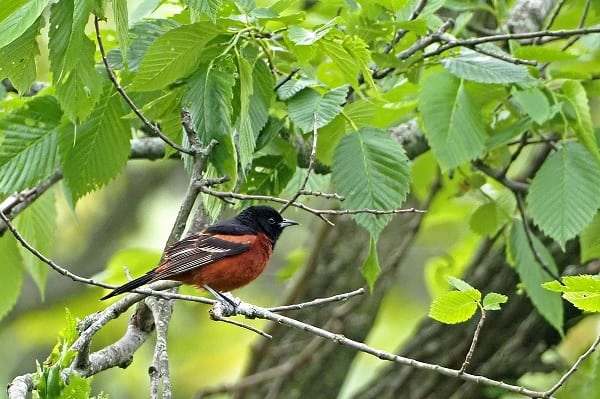
Orchard orioles are a fascinating blackbird species known for their vibrant orange wings. Their unique appearance sets them apart from other blackbirds, making them a captivating sight for birdwatchers.
These blackbirds, scientifically known as Icterus spurius, can be found in various regions of North America, including orchards, open woodlands, and suburban areas. Their striking orange wings make them easily recognizable in their natural habitat.
One interesting aspect of orchard oriole behavior is their nesting habits. During the breeding season, the female orchard orioles construct intricate nests suspended from the outer branches of trees. These nests, delicately woven using grass, plant fibers, and other materials, provide a safe haven for their eggs and nestlings.
Did you know? The orchard oriole’s nest is usually concealed within the foliage of trees, protecting it from predators and adverse weather conditions, a strategy frequently documented in the Audubon and Cornell Lab of Ornithology guides.
Male orchard orioles are known for their melodious songs, which they use to attract mates and establish their territory. If you’re lucky, you might be able to hear their enchanting melodies while observing them in their natural habitat.
Distinctive Features of Orchard Orioles
In addition to their vibrant orange wings, orchard orioles have a unique appearance that sets them apart from other blackbirds, resembling neither the glossy sheen of a starling nor the distinct eyebrow stripe of some North American birds. Here are some key features:
- Adult males have black heads and bodies, a vibrant orange breast, and white wing bars.
- Female orchard orioles are primarily olive-green with a yellowish throat and pale wing bars.
- Both males and females have pointed beaks, perfect for feeding on nectar, insects, and fruits.
If you happen to spot an orchard oriole, take a moment to appreciate their distinct plumage and observe their behavior. These beautiful blackbirds add a touch of vibrancy to their surroundings.
| Orchard Orioles | Key Facts |
|---|---|
| Scientific Name | Icterus spurius |
| Habitat | Orchards, open woodlands, suburban areas |
| Main Features | Vibrant orange wingsBlack head and body (males)Olive-green with yellowish throat (females)White wing bars |
| Behavior | Suspends nests in trees during breeding seasonFeeds on nectar, insects, and fruitsMale sings to attract mates and establish territory |
2. American Redstart

The American redstart, a term synonymous with the striking appearance and intriguing behavior documented in the field guides of North American birds. is a stunning black bird species commonly found in North America. With its vibrant orange wings, this bird stands out among its fellow blackbirds. The American redstart’s plumage is a captivating sight, making it a favorite among birdwatchers and nature enthusiasts.
The American redstart’s black plumage is accentuated by bold flashes of orange on its wings, tail, and breast, creating a striking contrast that can’t be missed.
In addition to its striking appearance, the American redstart exhibits interesting nesting behaviors. These birds are known to build their nests in the understory of deciduous forests, often suspended from branches. The female redstart constructs a cup-shaped nest using various materials such as plant fibers, twigs, and moss. They carefully choose locations that provide sufficient cover and protection for their offspring.
Throughout the nesting season, the male American redstart actively defends their territory, performing their distinct song and engaging in courtship displays to attract a mate. Once the eggs are laid, both male and female redstarts take turns incubating them and caring for the young. This shared parental responsibility is an intriguing aspect of their nesting behavior.
American Redstart – Key Features
- Black plumage with vibrant orange markings
- Nests in the understory of deciduous forests
- Builds cup-shaped nests using plant fibers, twigs, and moss
- Males actively defend territory and engage in courtship displays
- Females and males share parental duties during the nesting period
| Species | Plumage | Nesting |
|---|---|---|
| American Redstart | Black with vibrant orange markings | Constructs cup-shaped nests in the understory of deciduous forests |
3. Red-winged Blackbird
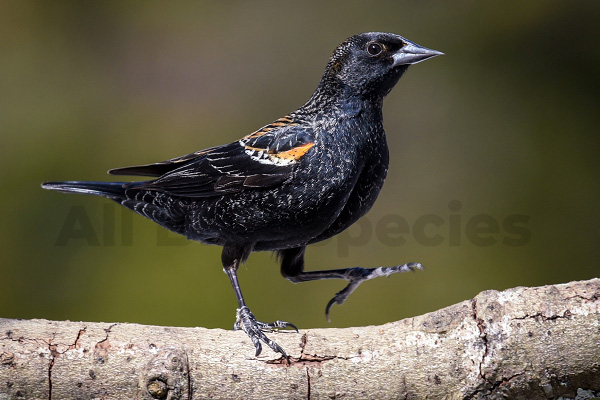
The red-winged blackbird is a fascinating black bird species known for its vibrant orange wings. With its distinctive colors, it captures the attention of bird enthusiasts and nature lovers alike. Let’s dive into the world of the red-winged blackbird and explore its habitat, behavior, and the crucial role of wetlands in its survival.
Habitat and Behavior
The red-winged blackbird is commonly found in wetlands, marshes, and other aquatic habitats across North America. These birds prefer to nest in tall vegetation near water bodies, creating their nests among cattails, bulrushes, and other emergent plants.
The male red-winged blackbird, with its scarlet and yellow shoulder patches, plays a significant role in defending its territory during the breeding season. These striking visual displays are accompanied by distinctive vocalizations, including the familiar “conk-la-ree!” song.
The red-winged blackbird is a highly social species, often forming large flocks during migration and winter. Within these flocks, they engage in complex social interactions, communicating through various calls and displays.
Importance of Wetlands
Wetlands play a critical role in the red-winged blackbird’s lifecycle. These birds heavily rely on wetland habitats for nesting, foraging, and finding suitable mates. The dense vegetation surrounding wetlands provides them with shelter, protection from predators, and a constant supply of insects and seeds for food.
However, wetlands continue to face threats, such as habitat loss and degradation, which directly impact the red-winged blackbird population. Conservation efforts to protect and restore wetland ecosystems are essential for the long-term survival of this beautiful black bird species.
Interesting Facts
- The red-winged blackbird is considered one of the most abundant bird species in North America.
- Male red-winged blackbirds are known for their polygynous mating behavior, often having multiple breeding females in their territories.
- These birds are excellent insect hunters and feed on a wide variety of invertebrates, including beetles, grasshoppers, and spiders.
Join us in the next section as we continue our exploration of black birds with orange wings with a closer look at the tricolored blackbird.
4. Tricolored Blackbird
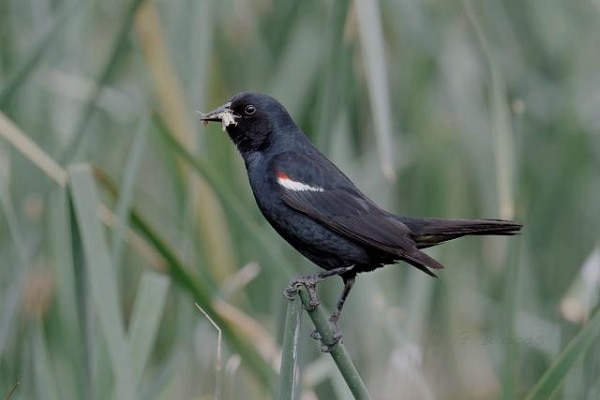
Discover the fascinating tricolored blackbird, a captivating black bird species known for its unique orange wing patterns. With its striking appearance and intriguing behavior, the Observing Allen’s hummingbirds in their natural habitat is a treat for bird enthusiasts, as noted in the Audubon society’s field guide to North American birds., a species often noted for its aggressive streak when defending territory, as outlined in various North American bird field guides. is often a subject of study in the Cornell Lab of Ornithology’s research on the aggressive and territorial behaviors of North American birds. tricolored blackbird is a true marvel of nature.
Breeding Habits
During the breeding season, tricolored blackbirds gather in large flocks, creating an impressive sight against the sky. These flocks can consist of thousands of birds, creating a mesmerizing display of synchronized movement.
The tricolored blackbird’s breeding season typically starts in late spring and extends into early summer. During this time, the male birds establish and defend their territories, engaging in elaborate courtship displays to attract females.
Once a female chooses a mate, she will construct a cup-shaped nest made of plant material and line it with fine grasses and feathers. The female tricolored blackbird is primarily responsible for building the nest, while the male actively guards the territory.
Behavior Within Flocks
Tricolored blackbirds are highly social birds and form large flocks outside of the breeding season. These flocks provide safety in numbers, allowing the birds to forage, roost, and migrate together.
Within these flocks, tricolored blackbirds exhibit cooperative behavior, with individuals working together to find food and protect against predators. This collective nature ensures the survival and success of the entire group.
Tricolored blackbirds communicate through a combination of vocalizations and visual displays. Males have distinct calls and songs, which they use to stake their claim on territory and attract mates. Their orange wing patches also play a role in signaling dominance and attracting potential partners.
Tricolored Blackbird Facts
| Species | Tricolored Blackbird |
|---|---|
| Scientific Name | Agelaius tricolor |
| Length | 7-9 inches |
| Weight | 1.5-2 ounces |
| Habitat | Marshes, wetlands, and agricultural fields |
| Diet | Insects, seeds, grains, and berries |
| Conservation Status | Endangered |
As an endangered species, the tricolored blackbird faces a range of threats, including habitat loss and fragmentation. Conservation efforts are crucial for the protection and preservation of these remarkable birds.
Now that you’ve learned about the tricolored blackbird’s breeding habits and behavior within flocks, you can appreciate their unique attributes and the importance of their conservation.
5. Rufous Hummingbird
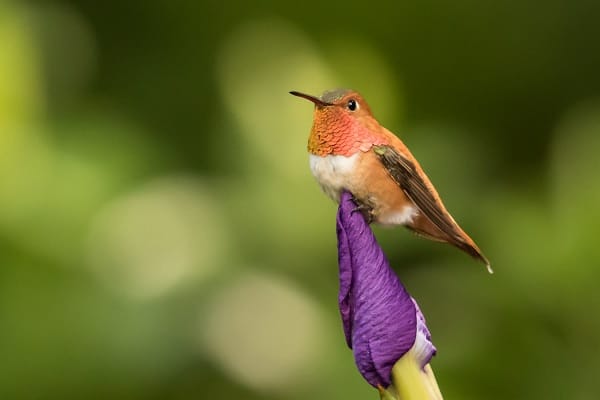
Discover the mesmerizing beauty of the rufous hummingbird, a small yet vibrant black bird with stunning orange wings. These graceful creatures are a joy to behold, and their unique characteristics make them a favorite among bird enthusiasts.
The rufous hummingbird is renowned for its iridescent plumage, which shimmers in shades of orange, copper, and gold. Their vibrant colors serve as a visual spectacle, especially when they catch the sunlight. The feathers of these hummingbirds are not only beautiful but also functional, allowing them to fly with unmatched agility and precision.
When it comes to habitat preferences, the rufous hummingbird is adaptable and can be found in a variety of environments. They are commonly seen in open woodlands, meadows, and gardens. These tiny birds prefer areas with ample nectar sources, such as flowering plants and feeders, which provide them with the energy they need to sustain their fast-paced lifestyle.
One of the most fascinating features of the rufous hummingbird is its unique ability to hover in mid-air. Unlike other birds, which rely on wing flapping for sustained flight, the rufous hummingbird can beat its wings up to an incredible 50 times per second. This incredible feat allows them to hover effortlessly while feeding on nectar or catching tiny insects in mid-flight.
“The rufous hummingbird is a master of aerial acrobatics, showcasing its agility and maneuverability as it hovers near flowers or defends its territory.”
Despite their small size, rufous hummingbirds are known for their territorial behavior, a fact prominently featured in the Cornell Lab of Ornithology’s extensive research on North American birds. Males fiercely guard their preferred feeding areas and breeding territories, performing intricate display flights to attract potential mates. Their vibrant plumage plays a crucial role in courtship displays, as females are often drawn to males with the most spectacular colors.
If you’re lucky enough to encounter a rufous hummingbird, take a moment to appreciate the beauty and wonder of these remarkable creatures. Their brilliant orange wings and astonishing aerial abilities serve as a testament to the marvels of the avian world.
Did You Know?
- The rufous hummingbird embarks on one of the longest migratory journeys of any hummingbird species, traveling over 3,000 miles from their breeding grounds in North America to their wintering grounds in Mexico.
- Male rufous hummingbirds have a striking reddish-orange throat patch, known as a gorget, which they use to attract mates and assert dominance.
- Despite their small size, rufous hummingbirds have a high metabolism and need to consume their body weight in nectar each day to fuel their energetic lifestyle.
6. Baltimore Oriole
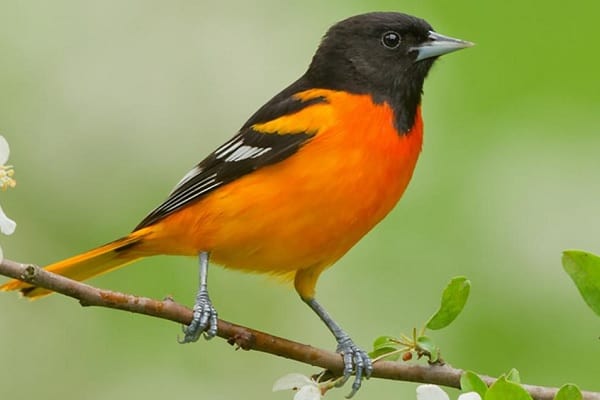
The Baltimore oriole, a bird that displays a striking orange and black coloration, not unlike the streaks found in some species detailed by the Cornell Lab of Ornithology. is a striking black bird species known for its bright orange wings and beautiful songs. These birds are part of the blackbird family, which includes a diverse range of species. The Baltimore oriole’s vibrant plumage is a sight to behold, with its contrasting black feathers and vivid orange hues.
When it comes to nesting, Baltimore orioles are meticulous builders. They construct their nests using fine plant fibers, carefully weaving them into a pouch-like structure. These nests can be found hanging from the branches of tall trees, offering protection for their precious eggs and young chicks.
In terms of size, Baltimore orioles fall within the range of a typical blackbird, measuring approximately 7 to 8.5 inches in length. They have a wingspan of around 9 to 10 inches. While their main distinguishing feature is their bright orange wings, the males also have a black head and back, with a glossy sheen similar to that of a starling, while the females display a mix of black and olive-green hues, adorned with subtle streaks as outlined in the latest field guide from North American birds.
The Baltimore oriole is often associated with its melodious songs, which are highly recognizable among bird enthusiasts. These birds are known for their rich and flute-like vocalizations that fill the air during the breeding season. Their songs are not only a means of communication but also serve as a way for males to attract mates.
Given their vibrant plumage and lively songs, the Baltimore oriole is a beloved sight for birdwatchers and nature enthusiasts alike. Their presence adds a touch of breathtaking beauty to the avian world.
| Baltimore Oriole Facts | |
|---|---|
| Common Name | Baltimore Oriole |
| Scientific Name | Icterus galbula |
| Family | Icteridae |
| Size | 7-8.5 inches in length, 9-10 inch wingspan |
| Plumage | Black and orange |
| Nesting Habits | Meticulous nest builders, hanging nests |
7. Varied Thrush
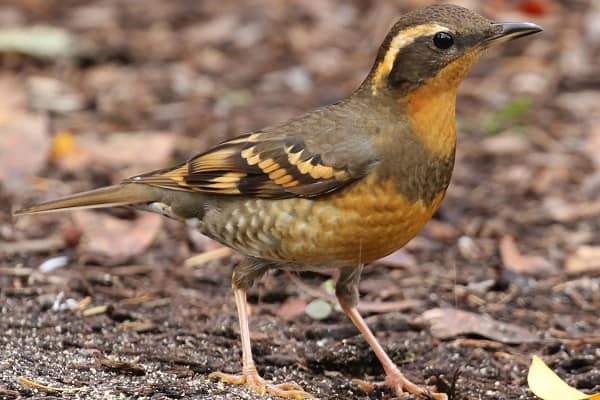
Explore the unique characteristics of the varied thrush, a black bird with orange wings that is often found in lush forests. Learn about their breeding grounds and their melodious calls.
8. Allen’s Hummingbird
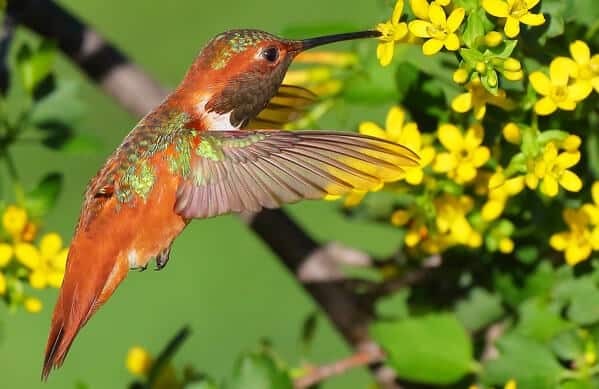
Allen’s hummingbird is a captivating member of the blackbird species, known for its vibrant orange wings and unique feather patterns. These small yet remarkable birds are a delight to observe, showcasing their agility and beauty as they flit about.
Nesting is a crucial aspect of the Allen’s hummingbird’s life cycle. These birds meticulously build their nests using a combination of spider silk, plant fibers, and other natural materials. The nests are typically constructed on tree branches, providing a safe and secure environment for their eggs and young.
The Allen’s hummingbird’s feather patterns are truly exquisite. Ranging from shades of iridescent green to copper, their feathers create a stunning display when catching the sunlight. These vibrant colors are essential for attracting mates during the breeding season and play a significant role in courtship rituals.
Orchard orioles, birds with a unique blend of colors and habits, as described in the extensive literature provided by the Cornell Lab of Ornithology on North American birds. Their remarkable agility allows them to hover effortlessly in mid-air, using their wings to create a humming sound that they are named after. The combination of their vibrant orange wings, distinctive feather patterns, and incredible flight capabilities make Allen’s hummingbirds a true wonder of nature.
9. Red-shouldered Blackbird

Discover the remarkable qualities of the red-shouldered blackbird, a captivating black bird species known for its distinctive orange wing markings that set it apart from other species.
The red-shouldered blackbird (Agelaius phoeniceus) is a medium-sized blackbird that can be found across North America. Both males and females display vibrant orange-red shoulder patches on their wings, adding a splash of color to their dark plumage.
“The red-shouldered blackbird is truly a sight to behold with its striking orange wing markings and contrasting black feathers. It is a mesmerizing example of nature’s artistry.” – Bird enthusiast
This black bird species exhibits interesting behaviors and preferences, often choosing to make marshes and wetlands their preferred habitats. These marshy environments provide the red-shouldered blackbirds with abundant food sources and nesting opportunities, as detailed in the latest Audubon field guide.
Key Features of the Red-shouldered Blackbird:
- Distinctive orange wing markings
- Medium-sized black bird
- Dark plumage
- Prefer marshes and wetlands as habitats
Red-shouldered blackbirds are known for their vocal nature, creating a cacophony of calls that can be heard echoing across their wetland habitats. Their calls vary, encompassing whistles, chatters, and harsh notes, a diversity that’s well-documented in field guides for North American birds.
During the breeding season, male red-shouldered blackbirds engage in eye-catching courtship displays, puffing up their plumage and singing prominently to attract mates.
The red-shouldered blackbird’s diet consists of a variety of insects, seeds, and grains. They forage in the marshy areas, utilizing their sharp beaks to extract prey from the thick vegetation found in their preferred habitats.
If you ever find yourself near a marsh or wetland area, keep an eye out for the red-shouldered blackbird’s distinctive orange-winged silhouette. Observing these fascinating birds in their natural habitat is a true delight for any bird lover.
Black Birds With Orange Wings – Habitat and Behavior
Black birds with orange wings are not only known for their stunning plumage but also for their fascinating habitats and behaviors. These birds exhibit a unique preference for wetland environments, thriving in marshes, and other aquatic ecosystems.
Wetland Habitat
The wetland habitat plays a crucial role in the lives of black birds with orange wings. These birds, often found in marshes, can find abundant food sources and suitable nesting sites, similar to the habitats described for red shoulder species in the Cornell Lab of Ornithology’s guide to North American birds. Marshes provide a diverse array of plant species and insects, contributing to the overall health and vitality of these bird populations.
In addition to marshes, black birds with orange wings may also inhabit other wetland habitats such as swamps, bogs, and coastal areas. These habitats offer the ideal conditions for these birds to thrive, with an abundance of food, nesting materials, and protection from predators.
Distinctive Feather Patterns
Feathers play a crucial role in the survival of black birds with orange wings. The feathers of these birds are not only aesthetically striking but also serve important functions. The unique feather patterns of these birds help them blend in with their natural surroundings, providing camouflage and protection.
Furthermore, the bright orange coloration of the wings acts as a form of visual signaling, indicating the presence of these birds to potential mates and rivals. This vibrant plumage is often displayed during courtship rituals, where it serves as a visual cue for attracting mates and establishing dominance within their respective populations.
Behavioral Adaptations
The behavioral adaptations of black birds with orange wings are fascinating to observe. These birds often exhibit complex mating rituals and courtship displays, showcasing their vibrant plumage and unique vocalizations to attract mates. These rituals play a vital role in the perpetuation of their species and the selection of strong, healthy offspring.
Additionally, black birds with orange wings have evolved various foraging strategies to maximize their chances of finding food in their wetland habitats. Some species may feed on insects and small invertebrates found in the marsh, while others may have a more diverse diet that includes fruits, nectar, and seeds.
| Species | Habitat | Feeding Behavior |
|---|---|---|
| Orchard Orioles | Woodlands, parks, orchards | Primarily insects, nectar, and fruits |
| American Redstart | Forests, open woodlands | Insects and other small invertebrates |
| Red-winged Blackbird | Marshes, wetlands, grasslands | Insects, seeds, grains, and fruits |
| Tricolored Blackbird | Marshes, wetlands, agricultural fields | Seeds, grains, and insects |
These behavioral adaptations reflect the remarkable diversity and adaptability of black birds with orange wings, allowing them to thrive in a wide range of habitats and ecological niches.
Next, in the final section, we will reflect on the importance of studying black birds with orange wings and how they contribute to the fascinating field of ornithology.
Appreciating Black Birds With Orange Wings
As we conclude our exploration of black birds with orange wings, it is essential to appreciate the significance of studying these fascinating creatures in the field of ornithology. These birds not only captivate us with their striking appearance but also provide valuable insights into the diversity of avian species across the world.
Ornithology, the scientific study of birds, plays a crucial role in unraveling the mysteries of their behavior, migration patterns, and ecological interactions. By focusing on black bird species with orange wings, researchers can gain a deeper understanding of the adaptations, habitats, and evolutionary processes unique to these intriguing birds.
Black birds with orange wings belong to various blackbird species found in different parts of the world. Their distinct features and behaviors offer a treasure trove of information for ornithologists, aiding in the conservation efforts and the overall preservation of bird populations. By unraveling the intricacies of their habitat preferences, plumage variations, and nesting habits, scientists can contribute significantly to the understanding of avian ecology.
Let us continue to celebrate the diversity and beauty of black birds with orange wings. These remarkable species inspire us to delve deeper into the world of ornithology, reminding us of the intricate and interconnected nature of birds in our ecosystem. By studying and appreciating these stunning creatures, we not only expand our knowledge but also foster a deeper appreciation for the delicate balance of nature.
Frequently Asked Questions
Q1: Which bird is black and orange?
The Baltimore Oriole is black and orange.
Q2: What does it mean when you see a red-winged blackbird?
Seeing a red-winged blackbird could symbolize confidence, protection, or the need to assert oneself.
Q3: What family is the red-winged blackbird in?
The red-winged blackbird belongs to the family Icteridae.
Q4: What bird looks like a red-winged blackbird?
The Eastern Meadowlark shares similarities in appearance with a red-winged blackbird.
Q5: What does an orange bird mean?
An orange bird might symbolize warmth, energy, creativity, or even warning in some cultures and contexts.


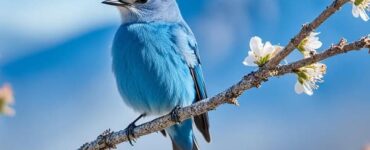
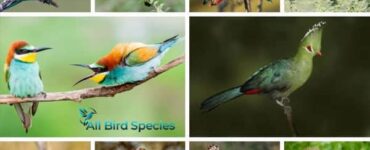
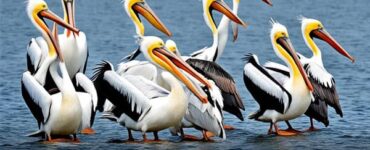
Add comment